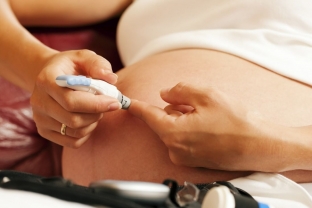Diabetes is one of the most widespread diseases affecting millions of people around the world. A dangerous pathology is characterized by an insufficiency of the pancreas, as a result of which too little insulin is released into the blood, while the level of glucose in the blood rises significantly. The danger of diabetes lies in the fact that the disease threatens the development of many serious complications, which can eventually lead to death. Why gestational diabetes can develop during pregnancy, and how to diagnose it - read today on estet-portal.com.
Gestational diabetes mellitus: how to detect the disease in time
Any disorder of carbohydrate metabolism that is first diagnosed during pregnancy is called gestational diabetes.
The period of pregnancy is one of the most difficult in a woman's life, because the developing fetus is a double burden on all organs and systems of the expectant mother. During pregnancy, chronic diseases often exacerbate and new pathologies appear. If a woman experiences metabolic disorders during pregnancy and is diagnosed with gestational diabetes mellitus, such a patient requires increased attention and a special approach in the management of pregnancy and maintaining the health of both the expectant mother and the fetus.
Gestational diabetes mellitus:
- risk factors for developing gestational diabetes;
- what happens in the body of a pregnant woman with gestational diabetes;
- Methods for diagnosing gestational diabetes mellitus.
Risk factors for gestational diabetes
Not every pregnant woman is at risk of developing gestational diabetes. The following risk factors for the development of this pathology are distinguished:
- overweight and obesity;
- impaired glucose tolerance;
- glucosuria during previous pregnancies or current;
- rapid weight gain during pregnancy;
- age over 30;
- complicated family history.
In accordance with these factors, there are three risk groups for the development of gestational diabetes:
- low risk group - the pregnant woman does not have any of the listed risk factors;
- moderate risk group - the woman has 1-2 risk factors, but no impaired glucose tolerance;
- high risk group - glucose tolerance is impaired and more than 3 risk factors are present.

What happens in the body of a pregnant woman with gestational diabetes
During normal pregnancy, two major changes in glucose homeostasis occur:
- glucose levels decrease faster as a result of its utilization by the fetus and placenta;
- from the second trimester of pregnancy tissue sensitivity to insulin decreases and insulin resistance may develop.
Against the background of these changes, a gradual compensatory stimulation of insulin production by pancreatic beta cells develops.
Such a pronounced increase in insulin resistance and the development of insulin deficiency distinguishes pregnancy with gestational diabetes from normal pregnancy.
Methods for diagnosing gestational diabetes
Gestational diabetes is diagnosed by measuring the blood glucose level of a pregnant woman. If there is at least one risk factor for the development of gestational diabetes, a woman is shown an oral glucose tolerance test. The criteria for making a diagnosis based on this test are as follows: fasting plasma glucose level - more than 5.1 mmol / l., after one hour - more than 10 mmol / l., after 2 hours - more than 8.5 mmol / l. All pregnant women should also have a glucose stress test, regardless of previous pregnancy results.








Add a comment